2013 MacBook Air: PCIe SSD and Haswell ULT Inside
by Anand Lal Shimpi on June 10, 2013 10:01 PM EST- Posted in
- Mac
- Storage
- SSDs
- Apple
- MacBook Air
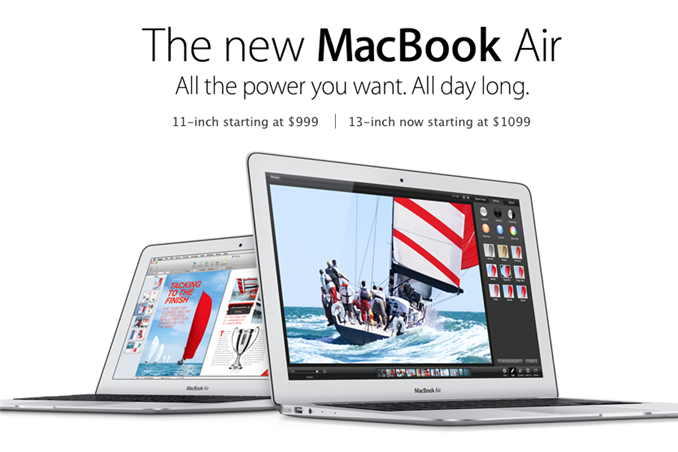
This morning Apple updated its MacBook Air to Intel's Haswell ULT silicon. The chassis itself didn't get any updates, nor did the displays. Both the 11 and 13 inch models retain their non-Retina 1366 x 768 and 1440 x 900 displays. There's a slight increase in battery capacity. The 11-inch model moves to 38Wh (8.6%) while the 13-inch model goes to 54.4Wh (8.8%). The big changes however are on the CPU, NAND and DRAM fronts.
With the new MacBook Air, Apple moves to a Core i5-4250U. The base clock drops to 1.3GHz across all of the models, but max turbo remains at 2.6GHz. Although the base clock is lower, I wouldn't expect substantially lower performance since the max turbo is unchanged as is the chassis that has to dissipate the thermals. To confirm, I ran a couple of Cinebench tests and generally found performance similar to that of last year's models:
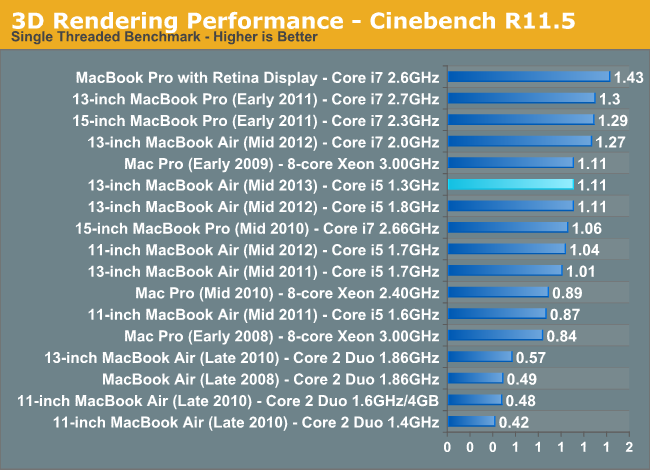
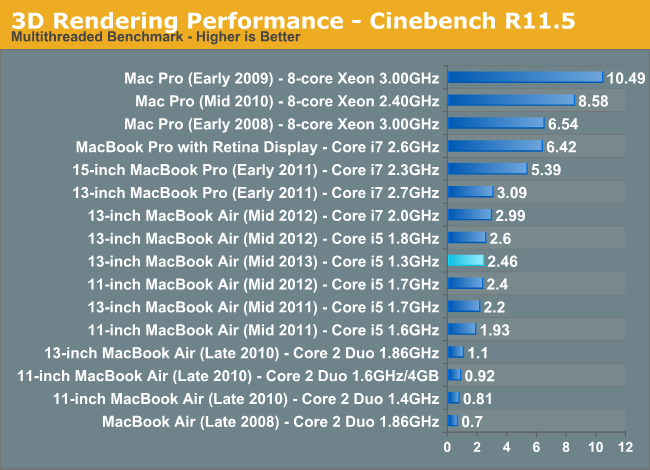
The 1.8GHz i5 in the 13-inch ended up being a bit quicker than the 1.3GHz 4250U this generation in the multithreaded test, but in single threaded performance the two are equal. The impact on the MT test is about 5%, it's there but not substantial. Don't be fooled by base clock, it's the combination of base clock, max turbo and cooling solution that'll determine performance here. As we found in our Haswell ULT review, CPU performance isn't something you can expect to see more of with Haswell vs. Ivy Bridge in these low wattage platforms.
You can get a 1.7GHz Core i7 upgrade with a 3.3GHz max turbo (i7-4650U). Both parts have Intel GT3 graphics clocked at a max of 1GHz on the i5 and 1.1GHz on the i7. Since the max GPU clocks are south of 1.2GHz, this is officially Intel's HD 5000 graphics and not Iris despite using the same silicon. The GPU base clock drops from 350MHz down to 200MHz, which should help reduce idle power consumption.
| 2013 MacBook Air Lineup | ||||||
| 11.6-inch | 11.6-inch (high-end) | 13.3-inch | 13.3-inch (high-end) | |||
| Dimensions |
H: 0.11-0.68" (0.3-1.7cm) W: 11.8" (30cm) D: 7.56" (19.2cm) |
H: 0.11-0.68" (0.3-1.7cm) W: 12.8" (32.5cm) D: 8.94" (22.7cm) |
||||
| Weight | 2.38 lbs (1.08kg) | 2.96 lbs (1.35kg) | ||||
| CPU | 1.3GHz dual-core Core i5 | 1.3GHz dual-core Core i5 | ||||
| GPU | Intel HD 5000 | |||||
| RAM | 4GB LPDDR3-1600 | |||||
| SSD | 128GB PCIe SSD | 256GB PCIe SSD | 128GB PCIe SSD | 256GB PCIe SSD | ||
| Display Resolution | 1366 x 768 | 1440 x 900 | ||||
| Ports | Thunderbolt, 2x USB 3.0, headphone jack | Thunderbolt, 2x USB 3.0, SD card slot, headphone jack | ||||
| Price | $999 | $1199 | $1099 |
$1299 |
||
On the storage front, Apple officially leads the charge with the move to PCIe based SSDs. The upcoming Mac Pro, as well as the new MacBook Airs both use PCIe based SSDs instead of SATA drives. A quick look at OS X's system profiler reveals a PCIe 2.0 x2 interface, capable of 1GB/s in each direction.
The drive in my system uses a Samsung controller, although I've heard that SanDisk will have a PCIe solution for Apple as well. A quick run through Quick Bench reveals peak sequential read/write performance of nearly 800MB/s:
This is a pretty big deal, as it is probably the first step towards PCIe storage in a mainstream consumer device that we've seen. I'm still awaiting official confirmation as to whether or not this is an M.2 based solution or a proprietary connector. Update: It's a custom Apple design, not M.2. Since there's no PCIe routed off of the CPU in Haswell ULT, these 2 lanes come from the on-package PCH.
The other big change is the move from DDR3L to LPDDR3, a new feature supported by Haswell ULT. I need to go back and dig through the Haswell ULT datasheets again, but I believe the total memory interface width remains at 128-bits wide even if you use LPDDR3 - you just get lower power consumption.
Obviously battery life is the biggest improvement here with the new MacBook Air. Thanks to Haswell's platform power optimizations, Apple claims up to 12 hours on a single charge for the 2013 13-inch MacBook Air. Given the improvements I saw in our Haswell ULT review, I don't doubt that we could see some very good numbers out of these notebooks.
I just got my hands on a 13-inch 2013 MBA and I'll be running performance tests (including the first look at Intel's HD 5000 graphics) over the coming days. I'm still traveling until Thursday but I'll do my best to run battery life tests while I'm on the road as well. More soon!


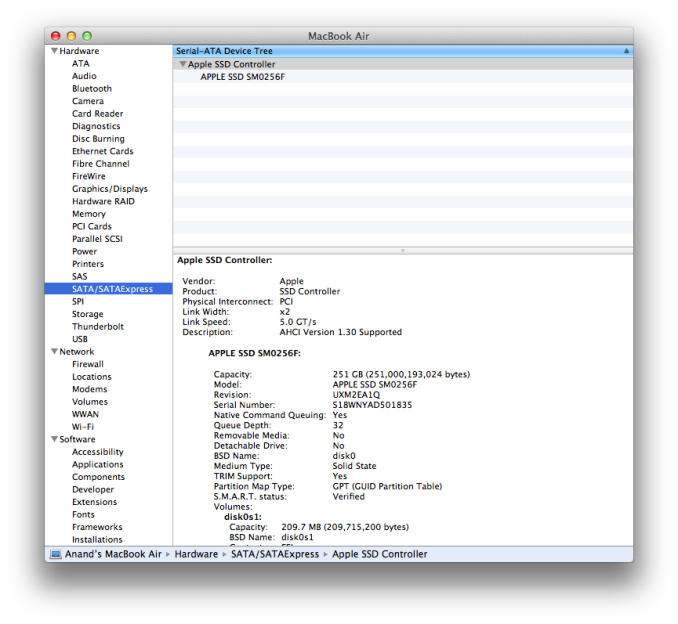

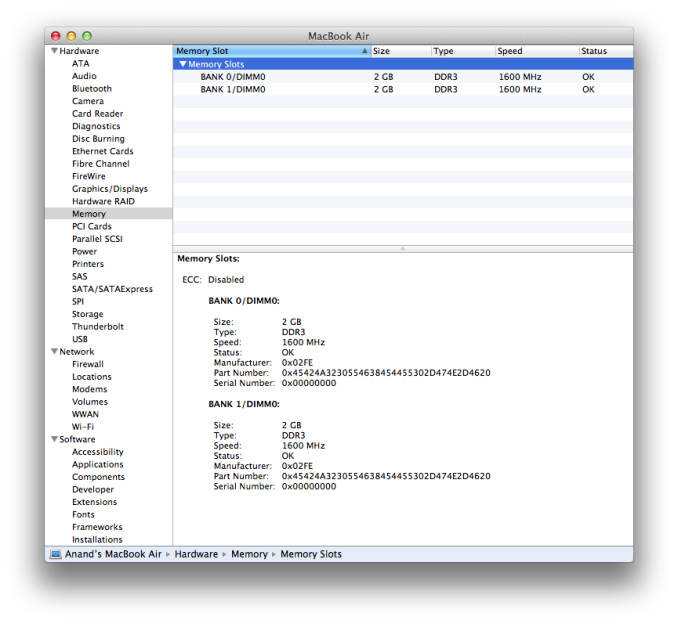








174 Comments
View All Comments
doobydoo - Wednesday, June 12, 2013 - link
If this were true, their competitors would match Apple's battery life.mavere - Wednesday, June 12, 2013 - link
OEMs are glorified hardware gluers; there's no reason to "admit" anything.Either the machine as a whole works well or it doesn't.
akdj - Wednesday, June 12, 2013 - link
"....You gotta admit, Apple didn't actually improve anything, Intel did."How sad. Did you even read the article teknic? Intel didn't put PCI-e SSD storage into the air. Intel didn't design the memory pipeline. Intel didn't deliver wireless AC, nor did they design the battery and thermals and internal protection from heat. Apple has to be reliant on Intel for their CPU and GPU. As does every other OEM. Your comment is ridiculous. As are about 70% of the rest in this discussion. Anand and his crew are easily the top shelf when it comes to technology insight and wisdom as well as their 'care and energy' they put into each and Every article and contribution. They're impressed with the storage. They're impressed with the battery life, new wireless protocol and Apple's engineered memory control. What is it that you do that leaves you so 'un' impressed? And what is it that every other OEM that relies on Intel to 'power' their rigs have or will have that Apple hasn't offered in a 2.5 pound package....able to essentially perform any and every task a non-power user could ever need? They offer a higher resolution screen in the rMBP which will surely be updated later this year when Intel releases the appropriate higher powered silicon. That's the only 'non' improvement made. Of course their workstations will improve in performance with the latest CPU offerings. It's how you implement that CPU as a 'system' that differentiates Apple from Sony from Samsung from Asus....et al
doobydoo - Wednesday, June 12, 2013 - link
For me battery life is far more important than an incremental CPU improvement which 90% of Macbook Air users wouldn't even notice. You don't buy a Macbook Air if you're doing anything seriously CPU/GPU bound. You buy one for portability and battery life, with enough performance to do all of the basic tasks such as web browsing, mail, document creation etc.The difference between what is actually a real 5-6 hours on the old Macbook Air to potentially 12 in the new one is staggering, it really changes how you can use the computer. A slightly faster CPU doesn't really do anything useful for this target market.
seapeople - Wednesday, June 12, 2013 - link
If you're not looking for battery life then why are you buying a MBA in the first place? They're not that much smaller than a rMBP, which would also, BTW, solve your lust after a high resolution screen. Second, if you you really want something super light and portable that has a high resolution screen, then buy a retina iPad.Oscarcharliezulu - Friday, June 14, 2013 - link
We all really want both, but I'd have to say, as someone who is always on client sites and travelling between meetings the performance has been good enough for a few years now even on C2D or C2Q so its definitely all day battery life which is the key improvementBkord123 - Tuesday, June 11, 2013 - link
Man you're killing me! I'm thinking about getting one and your points are valid. I would be upgrading from a mid-2009 MBP with the Core2Duo. After reading your comments, and the article, I'm a little bummed that the performance gains just aren't there. Do I hold out for another year?!?!?fteoath64 - Tuesday, June 11, 2013 - link
@Bkord123: Hold off for the MBP announcement!. There might be a surprise choice if Apple puts in a GT3e chip in the 13 inch and NV GT770M for the 15incher. And who knows might gun for a 17 incher with dual SSD in raid 1 mode running 1.6GB/s of disk!!. Yikes, would be a scorcher machine !.perpetuity - Tuesday, June 11, 2013 - link
Dude you have a 2009 MBP. I have a mid-2011 13" MPA after rolling with your rig. This is the best computer I have ever owned.It's light (homeles they do not need to lighten this thing), it's fast as hell, the screen is crisp and bright and battery life is decent.
I'll likely upgrade just for the slight bump in speed and the incredible battery life, plus I'll be getting a faster GPU in comparison to the Intel HD Graphics 3000 on my current MBA.
Macbook Air is the best computer you will own.
tim851 - Tuesday, June 11, 2013 - link
1. No redesignApple has established a design brand. Everybody knows a MacBook when they see one. And every other manufacturer envies that. Apple will not abandon that design until brand fatique - what you display: being bored with a design for no other reason than "it's been around so long, it's too familiar and it's omni-present" - dictates they have to.
2. still the same boring color gamut
Yeah, Apple must receive tens of calls everyday from consumers demanding better color gamut in the MBA...
3. no weight reduction
The MBA is sturdy as a rock. Can't imagine it being possible to reduce weight without compromising build quality. I prefer build quality.
4. no noticeable performance boost.
That's rather Intel's fault, isn't it?
5. Just more battery life and a price cut.
How rude of them...